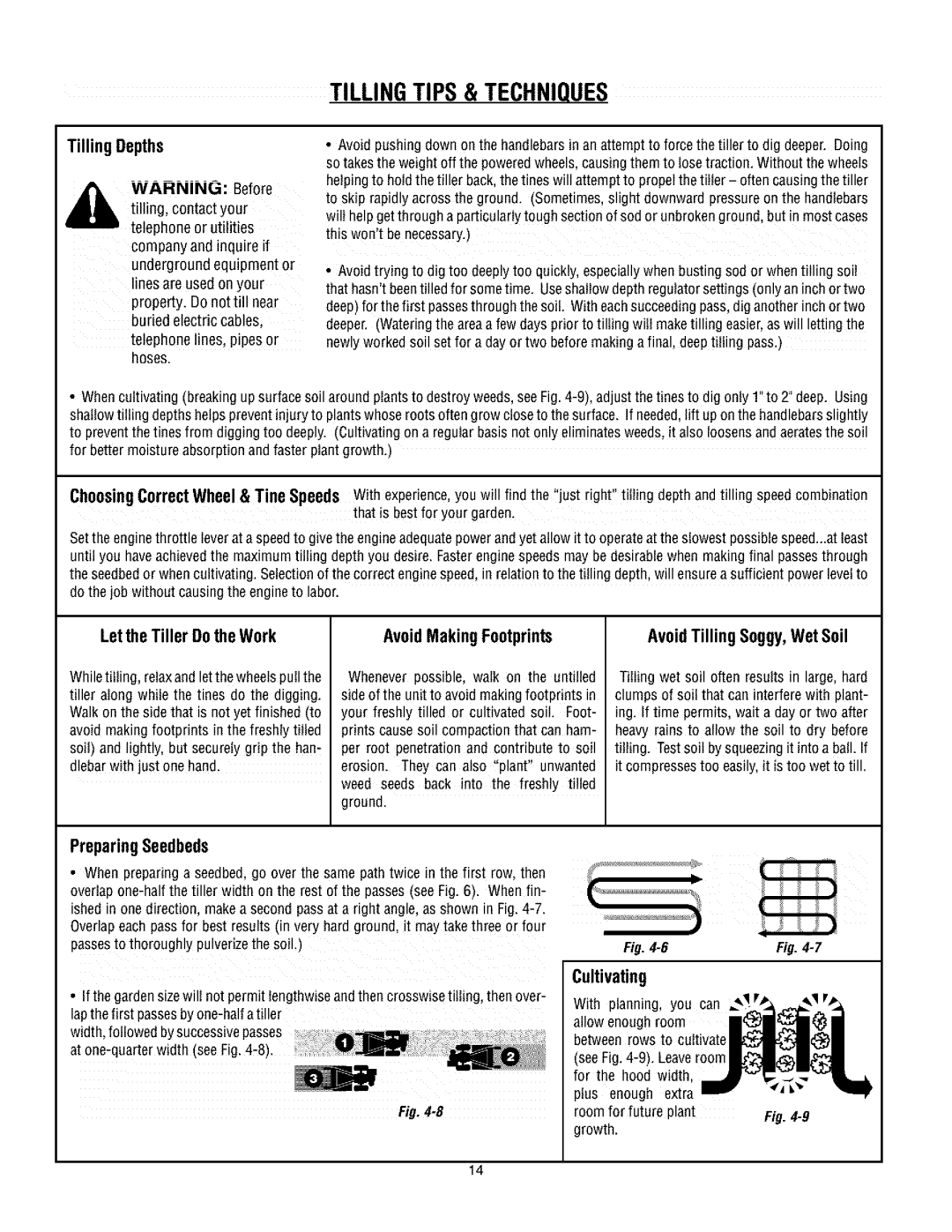
TILLING | TIPS & TECHNIQUES |
Tilling Depths
_=i, WARNING: Before A _ • tilling, Contactyour
,m ==== telephone or utilities company and inquireif underground equipment or lines are used on your property.Do not till near buried electric cables,
telephone lines, pipes or hoses.
•Avoid pushingdown on the handlebarsin anattemptto forcethe tiller to dig deeper. Doing so takesthe weightoff the poweredwheels,causingthemto losetraction. Without the wheels helpingto holdthe tiller back,the tineswill attemptto propelthe tiller - often causingthe tiller to skip rapidly acrossthe ground. (Sometimes,slight downwardpressureonthe handlebars will helpgetthrough a particularlytough sectionof sodor unbrokenground,but in most cases this won'tbenecessarY.)
•Avoid trying to digtoo deeplytoo quickly,especiallywhen bustingsod or when tilling soil that hasn'tbeentilledfor sometime. Useshallowdepth regulatorsettings(onlyaninch ortwo
deep)for the first passesthrough the soil. Witheachsucceedingpass,diganotherinch ortwo deeper. (Wateringthe areaafew daysprior to tilling will maketilling easier,as will lettingthe
newlyworkedsoil setfora dayortwo beforemakingafinal, deeptilling pass.)
•Whencultivating(breakingupsurfacesoil aroundplantsto
ChoosingCorrectWheel & Tine Speeds With experience,you will find the "just right" tillingdepth and tillingspeedcombination that is bestfor your garden.
Setthe enginethrottle leverat aspeedto give the engineadequatepowerandyetallow it to operateat the slowestpossiblespeed...atleast until you haveachievedthe maximumtilling depthyou desire. Fasterenginespeedsmaybedesirablewhen makingfinal passesthrough the seedbedor whencultivating.Selectionof the correct enginespeed,in relationto the tilling depth,will ensureasufficient power levelto dothe jobwithout causingthe engineto labor.
Let theTiller Dothe Work | AvoidMakingFootprints | AvoidTilling Soggy,Wet Soil |
Whiletilling, relaxandletthewheelspullthe tiller along while the tines do the digging. Walkonthe sidethat is not yet finished(to avoid makingfootprints in the freshly tilled soil) and lightly, but securelygrip the han- dlebarwith just onehand,
Wheneverpossible, walk on the untilled side of the unitto avoidmakingfootprints in your freshly tilled or cultivatedsoil. Foot- prints causesoil compactionthat can ham- per root penetration and contribute to soil erosion. They can also !'plant"unwanted weed seeds back into the freshly tilled ground.
Tillingwet soil often results in large,hard clumps of soil that can interferewith plant- ing. If time permits, wait a day or two after heavyrains to allow the soil to dry before tilling. Testsoil by squeezingit intoa ball. If it compressestoo easily,it is too wetto till.
PreparingSeedbeds |
|
|
• When preparinga seedbed,go over the samepath twice in the first row,then |
| D |
| ||
|
| |
ishedin onedirection, makea secondpassat a right angle, as shown in |
|
|
Overlapeach passfor best results (in very hardground, it maytakethree or four |
|
|
passesto thoroughly pulverizethe soil.) | Fig. | Fig. |
•Ifthe gardensizewill not permit lengthwiseandthen crosswisetilling,then over- lapthe first
Fig.
Cultivating
With planning, you can _ |
| _ r_ |
allowenoughroom | _ | |
betweenrows tocultivate | _ | _ |
_ | ||
for the hood width, |
|
|
plus enough extra _ |
| _' |
room for future plant |
| Fig. |
growth. |
|
|
14
